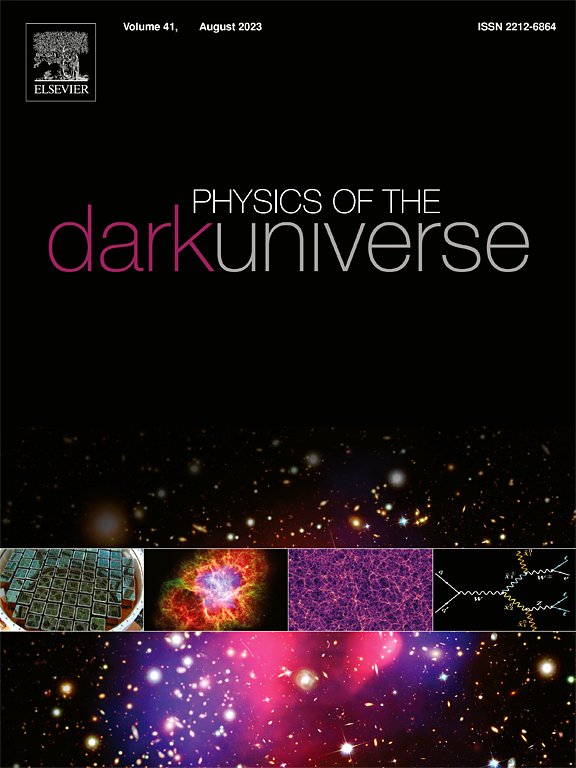旋转汤川修正黑洞:QNM和阴影研究
IF 6.4
2区 物理与天体物理
Q1 ASTRONOMY & ASTROPHYSICS
引用次数: 0
摘要
本研究研究了修正重力(MOG)中具有yukawa型标量场的旋转黑洞(BHs)的准正态模式(QNMs)和阴影,也称为标量-张量-矢量引力(STVG),并提供了使用事件视界望远镜(EHT)观测数据的测试。该度量包含了对MOG重力势的汤川类修正,其特征参数为α (MOG场强)和β(汤川场指数)。我们推导了相应的旋转黑洞解,研究了视界、遍历区、静态极限和有效质量,并分析了它们与黑洞和引力参数的依赖关系。我们计算了光球半径和阴影半径,我们的分析证实,增加黑洞的自旋减小了阴影的大小,增加了扭曲。相比之下,MOG和Yukawa场的存在导致M87*和Sgr A*在EHT数据的约束下阴影尺寸增大,在2σ置信区间产生α<;0.5和β≈0.2。此外,我们利用光子环参数与量子纳米频率之间的几何光学对应关系来研究赤道和极地量子纳米,以评估变形的影响。通过霍金辐射的能量发射率也被研究,与阴影半径有关。结果显示出与Kerr的偏差,EHT的兼容性有利于小Yukawa和STVG修饰。这些发现将理论预测与观测联系起来,限制了其他引力模型。本文章由计算机程序翻译,如有差异,请以英文原文为准。
Rotating Yukawa-modified black holes: QNM and shadow studies
This study investigates the quasinormal modes (QNMs) and shadows of rotating black holes (BHs) with a Yukawa-type scalar field in Modified Gravity (MOG), also known as scalar-tensor-vector gravity (STVG), providing tests using data from Event Horizon Telescope (EHT) observations. The metric incorporates Yukawa-like corrections to the gravitational potential in MOG, characterized by parameters (MOG field strength) and (Yukawa field exponent). We derive the corresponding rotating black hole solution, study the event horizon, ergoregion, static limit, and effective mass, analyzing their dependence on the black hole and gravity parameters. We calculated the photonsphere and shadow radii, and our analysis confirmed that increasing the black hole spin reduces the shadow size and increases the distortion. In contrast, the presence of MOG and Yukawa fields causes an increase in shadow size with constraints from EHT data on M87* and Sgr A*, yielding bounds like and at confidence for moderate spins. Furthermore, we study equatorial and polar QNMs using the geometric–optics correspondence between photon ring parameters and QNM frequencies, in order to assess the impact of the deformations. Energy emission rates via Hawking radiation are also studied, linking to the shadow radius. Results demonstrate deviations from Kerr, with EHT compatibility favoring small Yukawa and STVG modifications. These findings bridge theoretical predictions with observations, constraining alternative gravity models.
求助全文
通过发布文献求助,成功后即可免费获取论文全文。
去求助
来源期刊

Physics of the Dark Universe
ASTRONOMY & ASTROPHYSICS-
CiteScore
9.60
自引率
7.30%
发文量
118
审稿时长
61 days
期刊介绍:
Physics of the Dark Universe is an innovative online-only journal that offers rapid publication of peer-reviewed, original research articles considered of high scientific impact.
The journal is focused on the understanding of Dark Matter, Dark Energy, Early Universe, gravitational waves and neutrinos, covering all theoretical, experimental and phenomenological aspects.
 求助内容:
求助内容: 应助结果提醒方式:
应助结果提醒方式:


